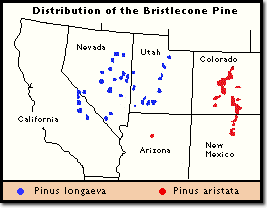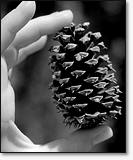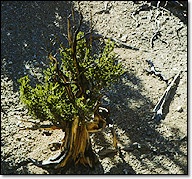|
 On dry windswept mountaintops of the Great Basin in the western United States grow earth's oldest living inhabitants, the bristlecones (Pinus longaeva, Pinus aristata). Many of the trees living today were seedlings when the pyramids were being constructed, mature in the time of Christ, and ancient patriarchs today. Bristlecones occur in only six western states, but of these the oldest are found at the Ancient Bristlecone Pine Forest in the White Mountains of California.
On dry windswept mountaintops of the Great Basin in the western United States grow earth's oldest living inhabitants, the bristlecones (Pinus longaeva, Pinus aristata). Many of the trees living today were seedlings when the pyramids were being constructed, mature in the time of Christ, and ancient patriarchs today. Bristlecones occur in only six western states, but of these the oldest are found at the Ancient Bristlecone Pine Forest in the White Mountains of California.


 Long ago, maybe 100 million years, the pines of North America were growing in the area now occupied by the Bering Sea. As the climate turned cooler, this plant community moved southward, adapting to geologic and climatic differences along the way. The bristlecone has adjusted to places on earth that no other tree wants to inhabit, and in these harsh environments, has flourished, free of competition.
Long ago, maybe 100 million years, the pines of North America were growing in the area now occupied by the Bering Sea. As the climate turned cooler, this plant community moved southward, adapting to geologic and climatic differences along the way. The bristlecone has adjusted to places on earth that no other tree wants to inhabit, and in these harsh environments, has flourished, free of competition.

 Until 1970 bristlecones were regarded as a single species. D.K. Bailey, an amateur botanist, demonstrated that the western most trees differ enough in structure of their needles and cones from the bristlecones of the eastern region, to warrant a new species name, Pinus longaeva. There are five needles per
fascicle
, 1 to 1.5" (2.54 - 3.81cm) in
Until 1970 bristlecones were regarded as a single species. D.K. Bailey, an amateur botanist, demonstrated that the western most trees differ enough in structure of their needles and cones from the bristlecones of the eastern region, to warrant a new species name, Pinus longaeva. There are five needles per
fascicle
, 1 to 1.5" (2.54 - 3.81cm) in
 length, with bottlebrush-like appearance on branches; male catkins red-purple (see photo below); female cones ovoid, dark purple to brown when ripe with incurved prickles on the scales that give the tree its name. (photo left)
length, with bottlebrush-like appearance on branches; male catkins red-purple (see photo below); female cones ovoid, dark purple to brown when ripe with incurved prickles on the scales that give the tree its name. (photo left)

 Bristlecones don't grow very tall, 60 ft. (18.3m) at the most, but usually much less. Girth of the largest one, the Patriarch is 36' 8" (11.2m), and this tree is relatively young at 1,500 years. The average age is about 1,000 years with only a few over 4,000 years. The oldest trees grow on outcrops of
dolomite
an alkaline calcareous substrate of low nutrient but of higher moisture content than the surrounding sandstone. The dolomite can reflect more sunlight than other rocks, contributing to cooler root zones, and saving moisture. The granite and sandstone formations surrounding the dolomite supports Limber pine (Pinus flexilis) and sagebrush (Artemesia tridentata) , but only on the alkaline dolomite will you find pure, relatively dense stands of bristlecone pine.
Bristlecones don't grow very tall, 60 ft. (18.3m) at the most, but usually much less. Girth of the largest one, the Patriarch is 36' 8" (11.2m), and this tree is relatively young at 1,500 years. The average age is about 1,000 years with only a few over 4,000 years. The oldest trees grow on outcrops of
dolomite
an alkaline calcareous substrate of low nutrient but of higher moisture content than the surrounding sandstone. The dolomite can reflect more sunlight than other rocks, contributing to cooler root zones, and saving moisture. The granite and sandstone formations surrounding the dolomite supports Limber pine (Pinus flexilis) and sagebrush (Artemesia tridentata) , but only on the alkaline dolomite will you find pure, relatively dense stands of bristlecone pine.

 Spring comes to the bristlecone pines in early May with the melting of snow and higher temperatures. Each year the tree increases in girth only 1/100th of an inch, often less, and new cones and twigs are formed. In this subalpine zone there are only three warm summer months, often only 6 weeks, to produce growth and reserves for overwintering. All of this must be accomplished on a mere 10" (25.4cm) precipitation. During cool summers, the trees live on energy produced that summer and grow on the reserves stored from the previous year. To live so long under such conditions, the bristlecone has established several strategies.
Spring comes to the bristlecone pines in early May with the melting of snow and higher temperatures. Each year the tree increases in girth only 1/100th of an inch, often less, and new cones and twigs are formed. In this subalpine zone there are only three warm summer months, often only 6 weeks, to produce growth and reserves for overwintering. All of this must be accomplished on a mere 10" (25.4cm) precipitation. During cool summers, the trees live on energy produced that summer and grow on the reserves stored from the previous year. To live so long under such conditions, the bristlecone has established several strategies.
|


 On dry windswept mountaintops of the Great Basin in the western United States grow earth's oldest living inhabitants, the bristlecones (Pinus longaeva, Pinus aristata). Many of the trees living today were seedlings when the pyramids were being constructed, mature in the time of Christ, and ancient patriarchs today. Bristlecones occur in only six western states, but of these the oldest are found at the Ancient Bristlecone Pine Forest in the White Mountains of California.
On dry windswept mountaintops of the Great Basin in the western United States grow earth's oldest living inhabitants, the bristlecones (Pinus longaeva, Pinus aristata). Many of the trees living today were seedlings when the pyramids were being constructed, mature in the time of Christ, and ancient patriarchs today. Bristlecones occur in only six western states, but of these the oldest are found at the Ancient Bristlecone Pine Forest in the White Mountains of California.


 Long ago, maybe 100 million years, the pines of North America were growing in the area now occupied by the Bering Sea. As the climate turned cooler, this plant community moved southward, adapting to geologic and climatic differences along the way. The bristlecone has adjusted to places on earth that no other tree wants to inhabit, and in these harsh environments, has flourished, free of competition.
Long ago, maybe 100 million years, the pines of North America were growing in the area now occupied by the Bering Sea. As the climate turned cooler, this plant community moved southward, adapting to geologic and climatic differences along the way. The bristlecone has adjusted to places on earth that no other tree wants to inhabit, and in these harsh environments, has flourished, free of competition.

 Until 1970 bristlecones were regarded as a single species. D.K. Bailey, an amateur botanist, demonstrated that the western most trees differ enough in structure of their needles and cones from the bristlecones of the eastern region, to warrant a new species name, Pinus longaeva. There are five needles per
Until 1970 bristlecones were regarded as a single species. D.K. Bailey, an amateur botanist, demonstrated that the western most trees differ enough in structure of their needles and cones from the bristlecones of the eastern region, to warrant a new species name, Pinus longaeva. There are five needles per
 length, with bottlebrush-like appearance on branches; male catkins red-purple (see photo below); female cones ovoid, dark purple to brown when ripe with incurved prickles on the scales that give the tree its name. (photo left)
length, with bottlebrush-like appearance on branches; male catkins red-purple (see photo below); female cones ovoid, dark purple to brown when ripe with incurved prickles on the scales that give the tree its name. (photo left)

 Bristlecones don't grow very tall, 60 ft. (18.3m) at the most, but usually much less. Girth of the largest one, the Patriarch is 36' 8" (11.2m), and this tree is relatively young at 1,500 years. The average age is about 1,000 years with only a few over 4,000 years. The oldest trees grow on outcrops of
dolomite
an alkaline calcareous substrate of low nutrient but of higher moisture content than the surrounding sandstone. The dolomite can reflect more sunlight than other rocks, contributing to cooler root zones, and saving moisture. The granite and sandstone formations surrounding the dolomite supports Limber pine (Pinus flexilis) and sagebrush (Artemesia tridentata) , but only on the alkaline dolomite will you find pure, relatively dense stands of bristlecone pine.
Bristlecones don't grow very tall, 60 ft. (18.3m) at the most, but usually much less. Girth of the largest one, the Patriarch is 36' 8" (11.2m), and this tree is relatively young at 1,500 years. The average age is about 1,000 years with only a few over 4,000 years. The oldest trees grow on outcrops of
dolomite
an alkaline calcareous substrate of low nutrient but of higher moisture content than the surrounding sandstone. The dolomite can reflect more sunlight than other rocks, contributing to cooler root zones, and saving moisture. The granite and sandstone formations surrounding the dolomite supports Limber pine (Pinus flexilis) and sagebrush (Artemesia tridentata) , but only on the alkaline dolomite will you find pure, relatively dense stands of bristlecone pine.

 Spring comes to the bristlecone pines in early May with the melting of snow and higher temperatures. Each year the tree increases in girth only 1/100th of an inch, often less, and new cones and twigs are formed. In this subalpine zone there are only three warm summer months, often only 6 weeks, to produce growth and reserves for overwintering. All of this must be accomplished on a mere 10" (25.4cm) precipitation. During cool summers, the trees live on energy produced that summer and grow on the reserves stored from the previous year. To live so long under such conditions, the bristlecone has established several strategies.
Spring comes to the bristlecone pines in early May with the melting of snow and higher temperatures. Each year the tree increases in girth only 1/100th of an inch, often less, and new cones and twigs are formed. In this subalpine zone there are only three warm summer months, often only 6 weeks, to produce growth and reserves for overwintering. All of this must be accomplished on a mere 10" (25.4cm) precipitation. During cool summers, the trees live on energy produced that summer and grow on the reserves stored from the previous year. To live so long under such conditions, the bristlecone has established several strategies.



 Survival strategies
Survival strategies

 Needles can live twenty to thirty years thus adding new foliage to that already on the tree,
Needles can live twenty to thirty years thus adding new foliage to that already on the tree,
 takes little energy. The long-lived needles provide a stable photosynthetic capacity to sustain the tree over years of severe stress.
takes little energy. The long-lived needles provide a stable photosynthetic capacity to sustain the tree over years of severe stress.


 Another strategy for surviving is the gradual dieback of bark and the tissue that conducts water
(xylem)
when the tree is damaged because of fire, lightning, drought or damaging storms. This reduction of tissue that the crown has to supply with nutrients, balances the effect of any damage sustained. The surviving parts remain quite healthy. As an example, "Pine Alpha" at over 4000 years, is nearly four feet in diameter, yet has only a ten inch strip of living bark to support it.
Another strategy for surviving is the gradual dieback of bark and the tissue that conducts water
(xylem)
when the tree is damaged because of fire, lightning, drought or damaging storms. This reduction of tissue that the crown has to supply with nutrients, balances the effect of any damage sustained. The surviving parts remain quite healthy. As an example, "Pine Alpha" at over 4000 years, is nearly four feet in diameter, yet has only a ten inch strip of living bark to support it.


 Invasions from bacteria, fungus or insects that prey upon most plants are unknown to the bristlecone due to their dense, highly resinous wood. The dry air common in the subalpine region can kill by
desiccation
, but also helps preserve the trees from rotting.
Invasions from bacteria, fungus or insects that prey upon most plants are unknown to the bristlecone due to their dense, highly resinous wood. The dry air common in the subalpine region can kill by
desiccation
, but also helps preserve the trees from rotting.


 Bristlecones can remain standing for hundreds of years after death. They fall because the supporting roots finally decay or are undermined by erosion.
Bristlecones can remain standing for hundreds of years after death. They fall because the supporting roots finally decay or are undermined by erosion.


 The oldest bristlecones live in the most exposed sites, with a considerable amount of
The oldest bristlecones live in the most exposed sites, with a considerable amount of
 space between each tree. The longevity of the bristlecone needles and the inability of other plants to grow in the dolomite soil make for little leaf litter or ground
cover. This distance in between, combined with the lack of ground cover, is how a tree can sustain a lightning strike, catch fire, and not have the fire spread to surrounding trees.
space between each tree. The longevity of the bristlecone needles and the inability of other plants to grow in the dolomite soil make for little leaf litter or ground
cover. This distance in between, combined with the lack of ground cover, is how a tree can sustain a lightning strike, catch fire, and not have the fire spread to surrounding trees.


 Even the oldest trees have the ability to produce cones with viable seeds.
Even the oldest trees have the ability to produce cones with viable seeds.

 The bristlecone pines have survived for unknown centuries. The current threat is from all the people who come to visit them. "Methuselah", the oldest tree, is not marked due to the threat of vandalism. The recording of past events provided by these trees, along with the great beauty are too valuable for us to lose. The bristlecones will survive on their own, but we must have enough respect for their place in the environment to assure their recordings of events yet to occur.
The bristlecone pines have survived for unknown centuries. The current threat is from all the people who come to visit them. "Methuselah", the oldest tree, is not marked due to the threat of vandalism. The recording of past events provided by these trees, along with the great beauty are too valuable for us to lose. The bristlecones will survive on their own, but we must have enough respect for their place in the environment to assure their recordings of events yet to occur.





